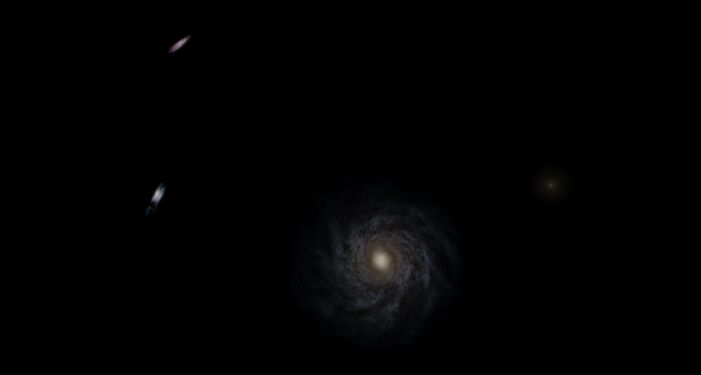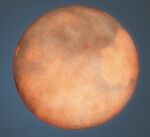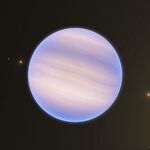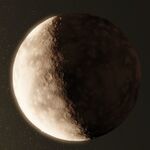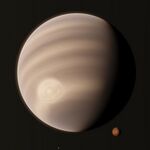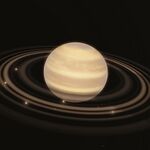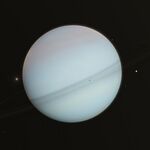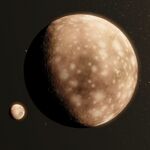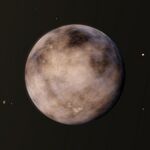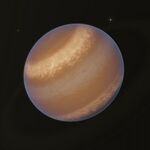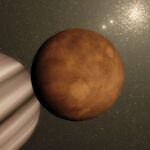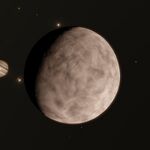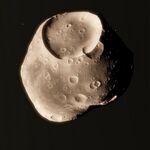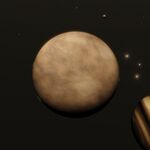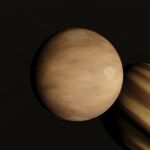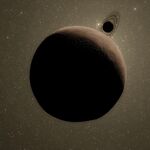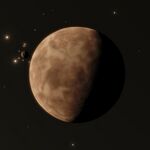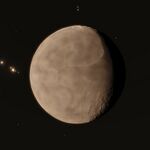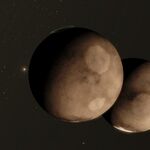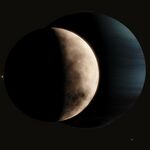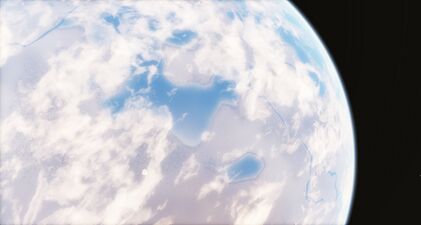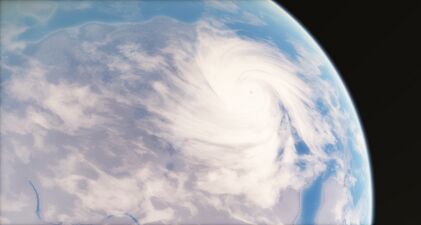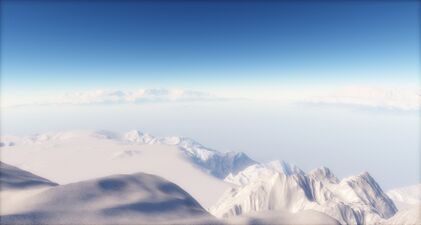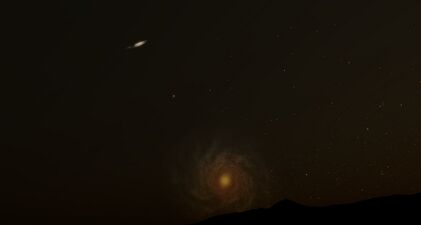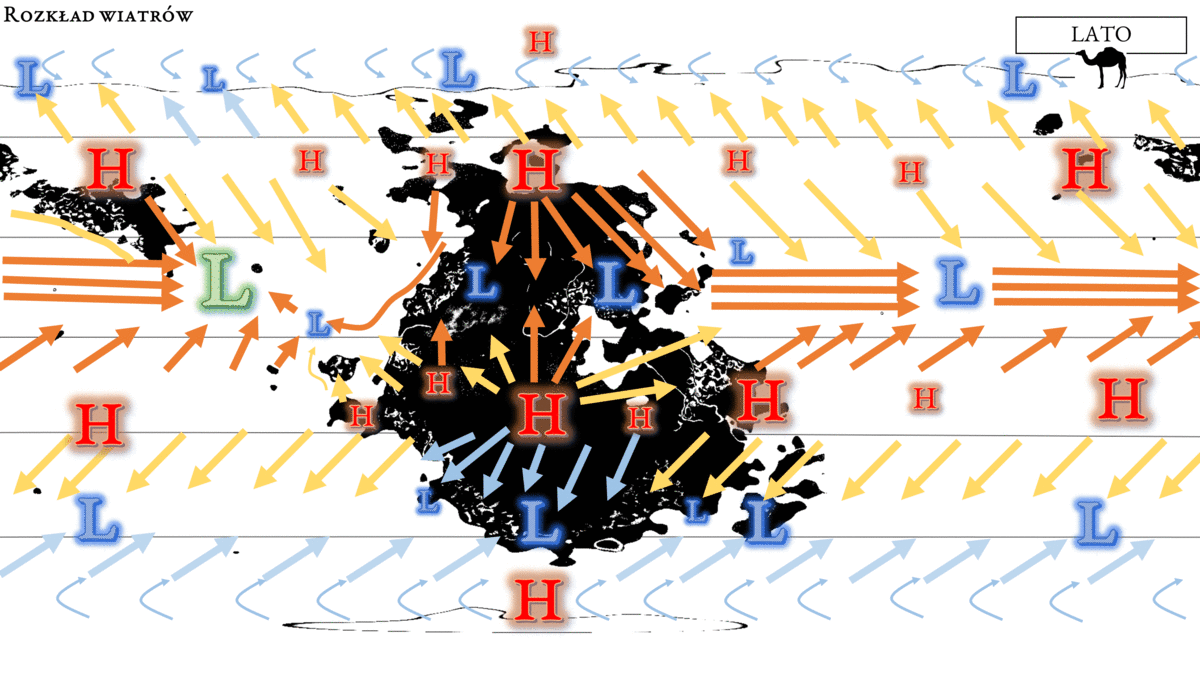Kyon
| Conworld project by PFJ[1]. | |
|---|---|
| KYON | |
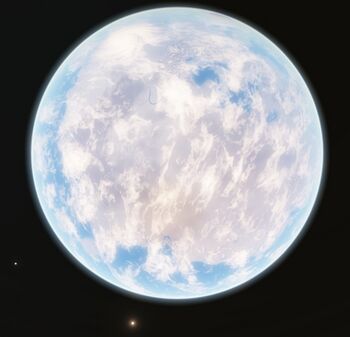 Kyon. Hound's planet. Tossed to the outskirts of its galaxy, far from other stars. | |
| About | |
| Status | actively developed as of 7.02.2021 |
| Founded in | 2015[2] |
| Scale | Multiple players 12 at peak |
| Led by | CanisV, Henryk Pruthenia, Borlach(2020+, de facto) - Henryk Pruthenia (2016-2019) - CanisV (2015-2016) |
| Founder | CanisV |
| Purpose | Thought experiment on evolution of cultures under vastly different night sky |
| Space Engine usage | Yes :: 0.9.7.3 beta Planet RS 8414-5-7-615188-1 5 (modified) |
| About the world | |
| Fiction | high realism (real laws of physics) - exceptions: terrestrial biology on foreign planet - those project continuations which go far beyond the contemporary |
| Imitation of Earth | low, a priori project |
| Origin of life | panspermia (approx. 1 million years ago) - Ancient Flora mod: flora 0.5 billion years ago) - Ancient Flora+ flora and calcite organissm 0.5 billion years ago |
| Project focus on times | equivalent of Earth's 1500s - exception: Canis's projects are focused on 1650s, 1750s, 1850s equivalents |
| Best described countries | Tangia, Aydinir, Neshi Country, Heptapolis, Olsenian Monarchy, Nuaria, Erutia, Tarum, Muria, Shur, Sekht, Pinu |
Kyon - a priori conworld jointly managed by members of the Polish Linguistic Forum[3], founded by CanisV in late 2015[4] with core idea of contemplating what cultures, mythologies and religions could emerge from a human population living under a dramatically different night sky. The world was carefully picked from Space Engine version 0.9.7.3 beta, as world RS 8414-5-7-615188-1 5 with slight planetary editing[5], and lies on the outermost edge of the Sculptor Dwarf Galaxy[6], facing the Milky Way from above. Name of Kyon (Greek for "dog", "hound") refers to nickname of its founder, Canis (Latin for the same).
The world has several rules, it can only contain humans, forbidding fictional creations such as elves or dwarves. Animals are permitted to span across the whole Neogene, permitting Tertiary and Quaternary fauna, especially megafauna, to coexist with the contemporary. Flora can have a longer span. Linguistically and culturally, the project allows only a priori[7] conlangs, although loose connections to Earth cultures are common, usually explained as convergence under similar conditions.
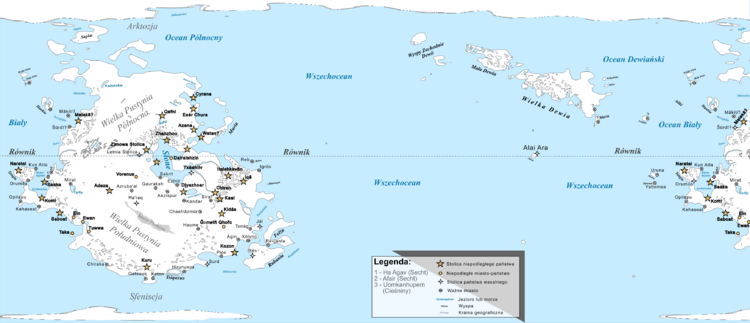
Key cities, valid for year 8973 EK, the common year. Map (in Polish language) used for discussing trade paths.
Kyon as a project assumes its human presence - and life in general - is a result of far-future of star-faring humans who left some of their people in specific spots on Kyon, but since then abandoned it. This aspect was served as irrelevant background trivia and has never been meant to be focused on, although with expansion of some projects, this base assumption became highly controversial, in particular with descriptions undergoing industrial revolution, when Kyon's flora is - under initial rules - only one million years old, and there is insufficient natural deposit of coal, fossil fuels and appreciated building materials such as limestone and marble. Kyon initially was meant to revolve around early 15th century civilisation level, and due to this, several modifications were proposed for individual users to claim:
- Ancient Flora modifies the initial assumption that life on Kyon is 1 million years old by making plantlife present since 500 million years ago. This allows for abundance of fossil fuels and with that, permits industrial revolution to occur.
- Ancient Flora+ adds to the above simple calcite organisms which allow limestone and marble to exist.
- Dynamic Flora modification adds a narrow fictional element to Kyon's plantlife as adaption to Kyon being different planet than Earth, where Kyonian flora would be capable of rapid adaptations to changing conditions and, in hard times, would create survival forms faster and more efficient than what terrestrial plants can do, and would cause very rapid and significant blooms (explosive growth) when conditions become favourable again. This is explained as adaption to Kyon's harsher, but predictable climate as proposed with Canis's "Camel and Shark" climatic model.
An extra modification called Sea of Flames was proposed by Canis on Borlach's territory, which would be an area of massive natural depression on the dried out sea of tectonic origins, similar to what happened on Earth with the Mediterranean[8]. The proposed area has a depth of 5 kilometres and atmospheric pressure of 1770 hPa at salty bottom, making the area one of the most hostile areas on Kyon. Sea of Flames was accepted by Borlach and with that eliminating the threat of conflicts with other players, modification became canonical.
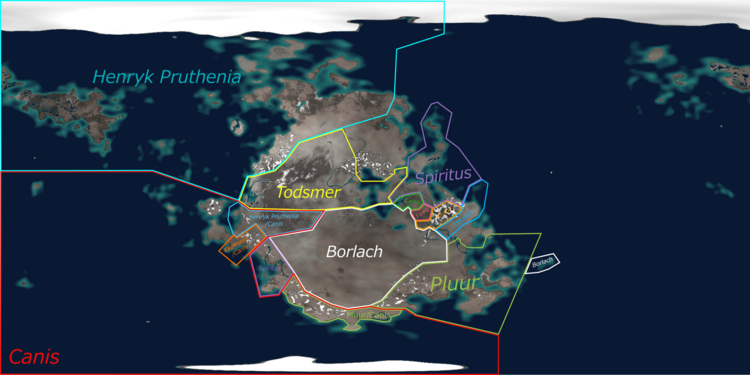
Areas of interest of particular players, September 2020.
Kyon underwent a large expansion of its content when up to twelve people, including many sharpest minds in the community, started quickly claiming plots of planetary topography as their areas of interest, which allowed them to put fictional cultures, nations and countries in there. Project's founder, CanisV, declared somewhere around 2017 that he is unable to keep up with the pace at which the project was being developed, which is when Henryk Pruthenia took over the lead. The project was well led and the spark of activity subsided naturally by 2019. At the start of 2020, Canis jumped back to the near-silent project, which saw large Wiki activity revolving Tangia, his conworld, including many innovations that helped present country articles in an eye-candy fashion, as well as cartographic developments. This, coupled with pandemic-induced focus on worldbuilding, resulted in Kyon project's renaissance, seeing numerous developments, including a mega-article about Aydinir by Borlach and a sophisticated global climate model for the world, as well as a jump in con-cartographic skills.
Astronomy and cosmological context
Parent galaxy of Kyon is not a work of fiction, it is a real galaxy called Sculptor Dwarf Galaxy (Scl dSph), about which Wikipedia has its respective article:
- https://en.wikipedia.org/wiki/Sculptor_Dwarf_Galaxy (English)
- https://pl.wikipedia.org/wiki/Karze%C5%82_Rze%C5%BAbiarza (Polish)
The galaxy is 290 000 light years away from the Solar system with Earth in it, in Milky May. It is a small, globular galaxy with old stars, which is a satellite galaxy to the Milky Way.
Photography of galaxy Sculptor Dwarf made by 2.2-metre large telescope of the European Southern Observatory (ESA).
Galactic data (Space Engine)
| Basic data | |
|---|---|
| English name | Sculptor dSph |
| Polish name | Karzeł Rzeźbiarza |
| Catalog | ESO 351-30 |
| A Milky Way satellite, dwarf galaxy. | |
| Basic Data | |
| Name | Sculptor dSph / ESO 351-30 |
| Class | E0 |
| Distance from Earth | 290000 ly |
| Abs. magnitude | -9m.80 |
| Number of stars | 52.171 million |
| Star clusters | 1 |
| Nebulae | 100 |
Parent star - Helios
Sun's location towards its galaxy and the Milky Way galaxy can be explained with the following draft:

Small circle on the left represents Sculptor Dwarf galaxy. The black star is the star around which Kyon revolves, Helios. Large circle distanced on the right is the Milky Way. Due to such positioning, Kyon's inhabitants have a starry side of the night sky, with densely packed stars of its host galaxy, and starless side of the night sky, where the whirlpool of Milky way and two Magellanic clouds are seen, and few stars. Note: graphic is not to scale, and the Milky Way's shield side is seen from Kyon, not its edge.
The star itself is slightly smaller than the Sun, in its younger stage, much like the whole planetary system. It is a singular system with one star of K2 V spectral type, 0.9 solar diameter and the mass of 0.76 M☉, corona temperature of 4626.9°C and luminosity 0.33. Rotation period is 22.8 terrestrial days.
To distinguish Kyon's sun from the Earth's sun, the Kyon's star is called Helios.
Stellar data (Space Engine)
| Basic data | |
|---|---|
| Catalog | RS 8414-5-7-615188-1 |
| Class | orange dwarf |
| Spectral type | K2 V |
| Abs. magnitude | 6m.04 |
| Planets | 12 |
| Physical properties | |
| Diameter | 1 251 083.625 km (0,89877 D☉) |
| Mass | 0.7553 M☉ |
| Density | 1.472 g/cm3 |
| Flattening | 0 |
| Effective temperature | 4626.9°C |
| Luminosity | 0,32545 |
| Rotation period | 22.839 Earth days |
| Axial tilt | 0°00'00".00 |
| Ascending node | 56°49'24".49 |
| Age | 3.319 billion years |
| Expected lifespan | 28.645 billion years |
| Gravity on equator | 257.64 m/s2 (26.263 g) |
| Gravity on poles | 257.64 m/s2 (26.263 g) |
| 1st cosmic velocity | 401.46 km/s |
| 2nd cosmic velocity | 567.75 km/s |
Planetary system
Helios's planetary system is one of the more interesting ones due to its uniqueness for Space Engine. While the planet Kyon itself was carefully picked, it is a result of coincidence that the system also had several unique properties for systems that could be found in Space Engine 0.9.7.3 beta:
- First planet is a superterra orbiting close to the sun, expelling such large amounts of material that seen from Kyon under right conditions will cause a trail to be seen called the "plume of fire". Hephaestus's trail is thrown off the planet in a similar way comets have their tails, and the reach of this tail extends far, even beyond Kyon's own orbit.
- There are two gas giants orbiting closer to Helios than Kyon does.
- Kyon's main moon, Lykaon, has volcanic activity, likely caused by colossal tidal stress.
Helios's planets are called using names from Greek mythology.
Twelve planets revolve around Helios, listed in the table below. The symbol ⴲ means Earth value (e.g. 1 Mⴲ - 1 Earth mass), symbol ♃ - refers to Jupiter. Time is provided in Earth time, e.g. days in terrestrial days (24h).
Colours in the table indicate:
- yellow - planets that can be seen from Kyon in rare cases such as a solar eclipse.
- blue - planets seen with naked eye
- red - planets not seen with naked eye
- Planetary dimensions were assumed comparable to Earth's, which eliminates the relevance of those statistics from Space Engine. The table above lists original parameters of Space Engine.
Moons
Below all moons that have a chance to be seen from Kyon with naked eye or a simple telescope are listed. Note, colours here mean moons of the same planet, so here the colours mean something different than in the planetary table above.
Other moons
All other moons with a diameter less than 1000 km.
| # | Diameter | Brightness magn. | Notes |
|---|---|---|---|
| 11.1 | 1.13 Dⴲ | 8.53 | |
| 11.2 | 0.63 Dⴲ | 9.80 | |
| 11.3 | 0.65 Dⴲ | 10.19 | |
| 11.6 | 0.09 Dⴲ | 13.97 | |
| 11.7 | 0.21 Dⴲ | 12.15 | |
| 11.10 | 0.11 Dⴲ | 13.66 | |
| 12.1 | 0.09 Dⴲ | 16.61 |
Kyon as a world and a planet
Conworld's actions take place on planet Kyon, where water-based life exists. Due to cosmological location of Helios as a star system, Kyon has two sides of the night sky:
- starry, where the observer sees tightly packed stars of its parent galaxy, the Sculptor Dwarf;
- starless, where instead of the stars, a large whirlpool of the Milky Way and two Magellanic Clouds are visible.
Depending on time, season and location, humans on Kyon can see the above in various combinations and at differing angles. The simulator, Space Engine, showed that in some places (northern parts of the planet) the night sky was completely dark for weeks, without any features. Due to the fact that Helios is not the last star from the galactic centre, always some 3 to 10 stars are visible even on the starless side, under ideal conditions. Night sky is affected by more factors, among them the Plume of Fire (blown off Hephaestos by stellar wind). As another example, south-equatorial parts (Tangia country), when simulation date was set to early January 2015, for a few weeks the starless part and Milky Way in it did not set on the horizon at all, instead, it half-sunk under it, rotated, and partially rose again.

Unusual angles at which bodies revolve are seen on the graphic above.
Red line indicates how Kyon orbits Helios. The picture presents large axial tilt of Kyon, and puzzling angles at which its three moons orbit the planet,
especially considering proximity of Lykaon.
Astrophysical data of Kyon generated by Space Engine was ignored. Size, gravity, atmospheric pressure and composition, humidity, average temperature, stellar flux, all were copied from Earth. There were, however, very significant differences:
- Kyon revolves around the sun once every 136.35 Earth days - that is the year on Kyon, shorter than on Earth.
- Kyon revolves around its own axis once every 1.813 Earth days, about 44.5 Earth hours - that is the day on Kyon, longer than on Earth.
- Axial tilt is larger than on Earth and is 31°18'54".36, larger than on Earth, affecting seasons.
- Kyon rotates retrograde, backwards towards the rotation direction of its star and the other planets.
- Moon Lykaon orbits at an odd angle and much closer to Kyon than Moon does to Earth, rising twice on the Sky within the same day, and causing enormous tidal effects. The effects are recognised, but largely ignored by the community, or it would render the planet inhospitable. One attempt at calculating their effects resulted in 100 metre tall oceanic tides which would spread salt very far onto the shores, however, peculiar orbital angle at which Lykaon revolves around Kyon makes any calculation attempts futile.
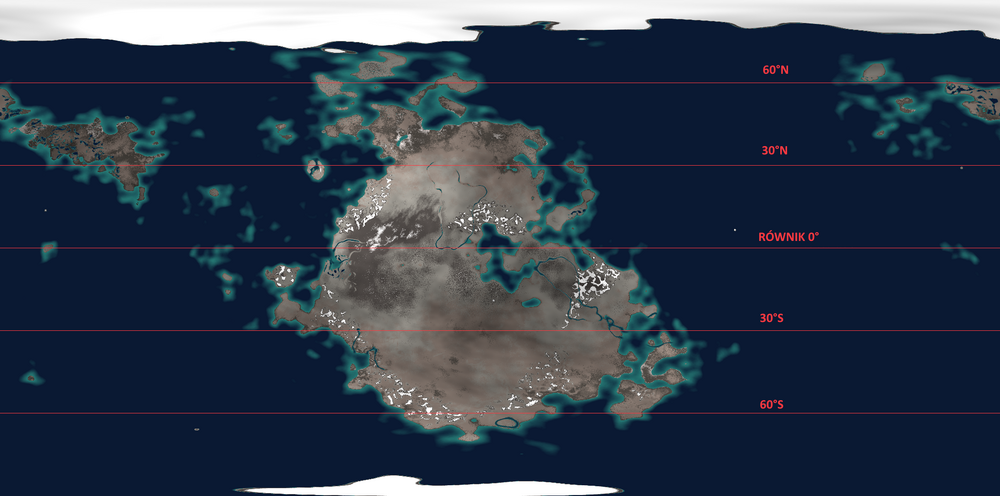
Surface map of Kyon.
Tangia seen from cosmos, on the left - Lykaon, both the moon and a night itself are important for this country.
Kynography - major topografic features
Words "geography" and "kynography" are both used to refer to Kyon's geography, as "geo-" generally means Earth and in astronomy is used to describe our Earth. Kyon has a Pangean-style topography with a supercontinent simply called "Kyon", large or small islands, and a large ocean called "Panthalassan" (Polish: "Wszechocean", meaning "all-ocean").
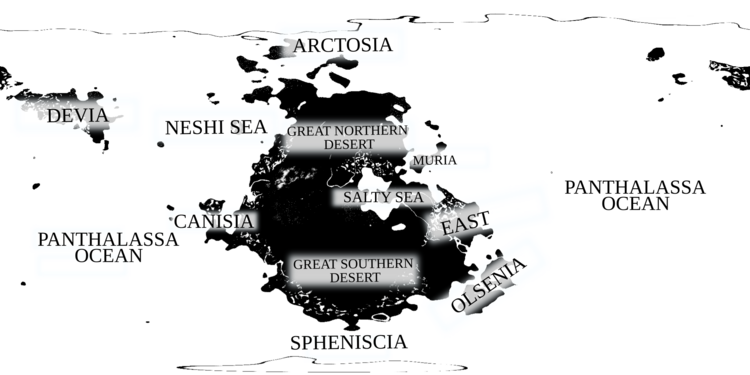
The one continent is divided into the following areas:
- Arctosia (arctos - "bear"), the Arctic regions.
- Great Northern Desert, largely uninhabited.
- Salty Sea, where oldest and most advanced civilisations such as Septupolis, Trugia and Aydinir lie.
- Great Southern Desert, divided from the Antarctic by southwest and southeast barrier mountains.
- Spheniscia (spheniscos - "penguin"), the Antarctic areas, where Nuaria lies.
- Olsenia - advanced nation in large southeastern isles.
- Muria - northweastern isles' inhabitants.
- Canisia - warm and tropical, where Tangia and Sekht lie.
- Neshi Sea - where highly advanced seafaring nation of the Neshi lies.
- Devia - islands, technically another continent, where various tribes live, gradually colonised by the Neshis.
- Panthalassa - grand ocean.

Kyon's early draft of climatic zones. No key in English exists to it, and the map is outdated.
Camel and Shark - climate
Kyon's climate was modelled a few times. Currently, the most advanced model is called "Camel and Shark". No matter which model is taken into account, there is a number of facts that need to be remembered when discussing Kyon's climate:
- Kyon has a supercontinent. This is a large barrier to oceanic winds and a large radiative zone. Its climate is different than modern Earth's, it is more similar to Earth's climate when it had a supercontinent - see Pangea[9].
- Kyon rotates slower than Earth. Its day lasts about 43.5 Earth hours, not 24 hours. This transfers more solar energy onto any illuminated area, while Kyon's winds and oceanic currents have less energy.
- Kyon revolves faster around its star than Earth. Seasons change sooner.
- Kyon has a large axial tilt, 31°18'54".36 instead of 23°26′11.9″. Seasons will be more dramatic, polar day/night zones will go further, and even the equator will experience seasons.

Kyon's range of polar day and night extend much farther than on Earth.
"Camel and Shark" model accept that a rotating planet will inevitably have its troposphere divided into several zones. Equatorial area receives the most heat, its illuminated surface rises up, lowering pressure at ground level and raising it at stratosphere. That excess air will flow sideways proportional to power of solar flux and after it cools and slides down, dried, will flow down, creating a high pressure zone at the tropics. That is called a Hadley cell. Because Kyon's days are stronger, but rotation speed is slower, the Hadley cell is larger than on Earth. Contrary to Artifexian, a popular YouTuber, in his video about this subject[10], who claimed that a planet rotating twice as slow as Earth would have two (northern-southern) cell, actual academic documents appear to deny this being the likely result. Ithaca, New York's Cornell University document by Yohai Kaspi and Adam P. Showman titled "Atmospheric dynamics of terrestrial exoplanets over a wide range of orbital and atmospheric parameters" with trustworthy methodology explained that as rotation speed slows down, the Hadley cells become almost global[11], which indeed happens on places such as Venus and Titan, but those objects also rotate not twice as slow as Earth, but hundreds of times slower. Kyon is in an intermediate stadium between those and thus it has a large Hadley cell, but not by any means a global one.

Kyon's Hadley cell is bigger because of its slow rotation speed. This pushes the tropics, where dry high pressure areas exist, much farther from the equator.
What is responsible for the biggest influence on Kyon's climate is its large axial tilt of 31°18'54".36. Due to it, even equatorial areas experience some seasons. Those seasons are shorter than on Earth, but stronger. Something called "thermal equator" bounces north and south to a much farther degree on Kyon than on Earth. A thermal equator is the belt of the most powerfully illuminated area by the Sun, a phenomenon which controls how climate works.
The titular "camel" and "shark" refer to a proposed massive oceanic oscillation, somewhat similar to La Niña - El Niño oscillation. This means that there exists an huge area of oceanic low pressure on average every two Kyonian years (but possibly up to about ten) travels between the Sekhtonese peninsula and the Atirai island. When the former happens, the circumequatorial flow of air is unobstructed and becomes global, pumping into the Kyon's otherwise dried continent, specifically its equatorial areas, large amounts of humidity, to which dynamic flora reacts with explosive bloooms, and sands rapidly overgrow with jungles. Due to this being a humid phase for most of Kyon, it's called the "shark" phase. When the latter happens, called the "camel" phase, grand oceanic central low pressure area retreats above the Atirai island, locking moisture there to such degree that it would reverse global winds against planetary rotation, as it likely happened on Earth once[12]. This would result in dramatic drying of equatorial Kyon into a desert, and for dynamic flora to retreat into survival forms.
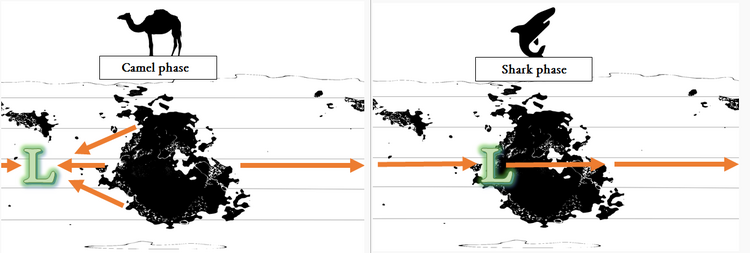
Grand central oceanic low pressure area shifts from Sekhtonese peninsula to Atirai island every two years on average.
Shark phase pumps moisture onto the continent's equator, to which Kyon's dynamic flora reacts with an explosive bloom into a jungle belt.
Camel's phase reverses major winds against the direction of planetary rotation, turning the continent into a desert.
Kyon's climatic modelling has a major flaw, it behaves as if with movement of thermal equator, Coriolis force would travel along. That is a mistake, as thermal equator is dependent on location of the greatest solar flux, while the Coriolis force is depended only on planetary's physical rotation. That error is accepted, but not corrected, as computing the result of a collision of migrating thermal equator with Coriolis force would require a much higher sophistication than needed for the conworld.
All those factors combined result in large climatic changes to weather in individual areas:
References for climate
- Cambel icon: icons made by Freepik from www.flaticon.com
- https://medium.com/universe-factory/climate-modeling-101-4544e00a2ff2
- https://www.researchgate.net/publication/230890352_Climate_of_the_Supercontinent_Pangea
- https://www.ldeo.columbia.edu/~polsen/cpcp/parrish_93_sm.pdf
- https://www.sciencedirect.com/science/article/abs/pii/S1342937X19300127
- https://www.researchgate.net/publication/236617752_Correlation_between_global_solar_radiation_and_air_temperature_in_Asturias_Spain
Countries
Countries in general are divided onto levels of civilisational advancement. The division is as follows:
| Comparison | Example of administration |
Example of military |
Civilisational level | Description | Examples | |
|---|---|---|---|---|---|---|
| Level 0 | Animals | Various | Fangs, claws and venom | None | Below any human culture | None exist |
| Level 1 | Primitive cultures | Tribal structure | Stone weapons, wooden or of found metal (swords, spears), glass arrowheads, poisoned arrows | No metalworking skills. Simple mud huts, control of fire, basic tools allowing to work with skins, ropes and bows. Achievements not exceeding achievements of most animals except for speech, fire control and ropemaking. | Simple hunting-gathering and nomadic cultures. | Pinu peoples |
| Level 2 | Simple civilisation | Tribal structure or intertribal ties | Metal tools, arrowheads and knives from glass. | Writing. Simple temples, relevant totems, monuments and figurines. Mixed agricultural-hunting-gathering economy. | Tribes on a higher development level with well developed trade. | Wuzang |
| Level 3 | Civilisation | Harsh feudalism with princes and monarchs on top | Highly developed army with its own spy network. Political structures and gendarmerie. Simple, wooden siege machines, first impressive stone fortresses. War navy. | Simple schools. Economy based primarily on agriculture and taxation or tribute, to a lower extent on trade. Sewage system might appear. | Comparable to western Europe of 9th century. | Kavelia |
| Level 4 | Highly developed civilisation | Parliament might appear | Serious siege machinese. Cannons and primitive firearms, bombs. Well developed navy. Large fortresses. | Education and schools on a very high level, serious exploration of the world, contacts between researchers across the globe. Well developed trade and services, as well as medicine. Postal system, fireworks, network of roads. | Civilisation comparable to Arabic world's of 13th century. | Sekht |
| Level 5 | Peak of civilisation | Efficiently functioning state and administration | Powerful army and navy, firearms of larger meaning. Simple artillery, including siege ones (mortars). | Accessible books, well developed cartography, advancements in medicine. Some basic human rights, intense works over chemistry, astronomy and engineering. The peak's a simple steam engine (still without purpose). | Civilisation comparable to level of western colonial empires of 15th-16th centuries. | Tangia |
The table above describes what could be seen in year 8973 EK. CanisV goes further with this and described his countries of 9509 EK (later age of discovery), 9640 EK (age of colonial empires) and 9750 EK (peak of colonial empires), up to speculations of 10000 EK (industrial revolution).
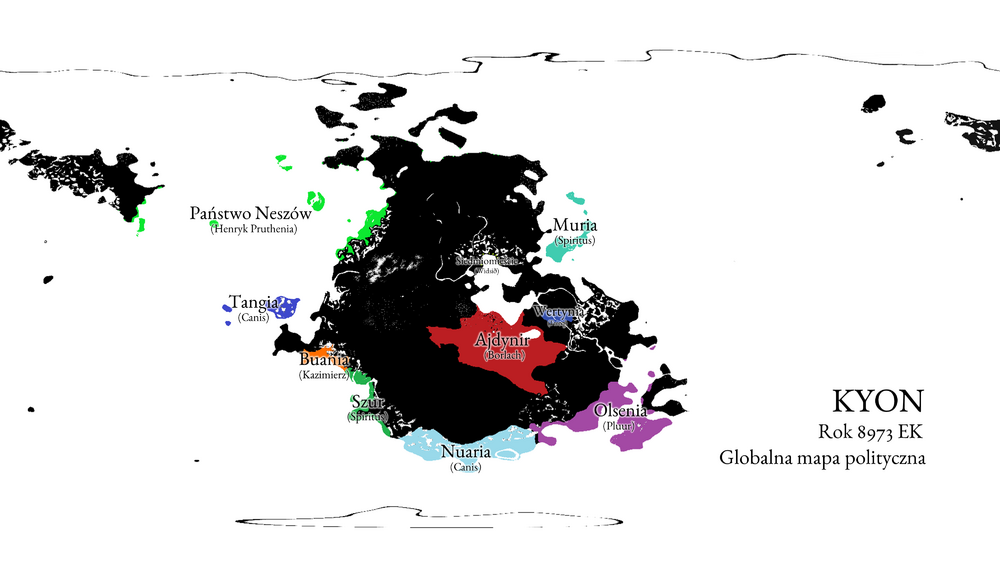
Kyon in year 8973 EK and its players. Note: Trugia is missing from the picture, it would be to the west of "Siedmiomieście" (Heptapolis).
Best developed and most relevant countries (class A projects)
List of countries for year 8973 EK is contained below.
| Level | Country | Emblem | Location | Population | Area | Capital | Religion | Region | Climate | Currency | Import | Export | Manager | |
|---|---|---|---|---|---|---|---|---|---|---|---|---|---|---|
|
Tangia year 8973 EK |

|

|
20 000 000 | 1 150 430 km² | Naratai | Karaism | Canisia Western Kyon |
Tropical and warm | aotai (AHT) | gold, wood, food, medicines, textiles, raw materials, slaves | rubber, optics, pearls, ships, bones, maps, amber, slaves, luminescent fluids, processed goods: armour, ropes, mirrors, vessels, wheels, barrels, chests, building components | CanisV | |
|
Aydinir | 
|

|
35 000 000 | 9 076 545 km² | Djyazhoar | Karism | Central Kyon Salty Sea |
Hot desert | adrash (ADR) | rubber, decorations, salt, paper, optics, iron, slaves, luminescent fluids, gunpowder, porcelain | medical knowledge, medicines, ḱagozhi herb, ayiritana, Aydinirian wines, carpets and incenses, saffron, perfumes, marble, gemstones, crystal, lapis lazuli, Ozarian ebony, Gąruwan wood, textiles and sails, incenses, myrrh, agricultural shoots, xerophytic food, slaves, produce: Aydiniarin, Mhasal, Taharen, Wares, Sarnak, Mnari, Affair | Borlach | |
|
Nešši Country | 
|

|
43 250 000 | 1 911 395 km² | Melekē | Kērosutoccu | North | Temperate, marine | potatoes[1] | hide and bones, meat, dyes, precious stones, exotic wood, technology, food, plants | gold and silver, other precious minerals, ores, agricultural shoots, food, wood, furniture, furs, sculptures, clothing, dyes, smelting products, technologies | Henryk Pruthenia† | |
|
Septupolis | 
|

|
3 384 450 | 10 000 km² | de iure none de facto Zhanzhou |
Bohenism | Central Kyon | Hot, humid | 1 Pù (園 pù) = 8 bân (園十) = 64 kàp (園百) | Widsið† | |||
|
Olsenian Monarchy | 
|

|
18 000 000 | 5 045 265 km² | Kozon | Łăpism | East | Temperate-cool | pyd | rubber, paper, luminescent fluids, gunpowder, Aydinirian herbs, carpets, incenses, optical instruments | charcoal, metal ores, metal produce (furnaces, pots, vessels, cutlery, decorations), wood, wooden produce (furniture, decorations, daily utilities), pasteurised and powdered food, chemical and medical knowledge, musical instruments (blown, with strings) | Pluur | |
|
Surd Dependence of Olsenian Monarchy |

|

|
200 000 | 142 179 km² | Surd | Łăpism | South | Cool | pyd | food, rubber, paper, luminescent fluid, gunpowder, sails, clothing | charcoal, wood, wooden produce (furniture, decorations, daily utilities), pasteurised and powdered food, musical instruments (blown, with strings) | Pluur | |
|
Muria | 
|
25 000 000 | 4 258 118 km² | Watan | Religion of the Murs | East | Temperate marine | ? | slaves, food, medicines, luxury products | copper, silver, paper, gunpowder, navigation instruments, tea, glass, porcelain | Spiritus | ||
|
Pinu | 
|

|
250 000 | 1 058 701 km² | Komi | Canisia | Hot, humid, equatorial | seashells gemstones |
weapons, vessels, completed products | food, wood, metals | Canis | ||
|
Buania | 
|

|
? | 900 087 km² | Saboat | Canisia | Hot, warm, temperate | hoañ | weapons, infrastructure, decorations, food | wood, food, keha | Kazimierz, CanisV | ||
|
Nuaria | 
|

|
547 801 | 2 242 382 km² | Kuru | Spheniscia (Antarctic) | Frigid antarctic | Skon, masoq, lan | food, fire fuel, shipbuilding materials | gold, silver, platinum, gemstones (diamonds, rubies, sapphires, emeralds, etc.) | CanisV | ||
|
Shur | 
|
13 600 000 (estimated) |
1 040 737 km² | Tuwwa | Enenke Religion | Canisia | Temperate | Enenke sikur | infrastructural solutions, paper, spices, glass, tropical food (speculation) |
wood, food of temperate climate (speculation) |
Spiritus |
† - means player is no longer in the community and isn't likely to return.
Lesser developed country projects (class B projects)
Poorly described countries.
| Name | Author | Last update |
Map | Commentary |
|---|---|---|---|---|
| Azenia / Hwatung | Widsið† | 2017-11-25 | No map | Weakly described |
| Bolosia | Henryk Pruthenia† | 2017-07-23 | Useless map, unintelligible | Miserable quality article, just 1 edit. |
| Jaugria | Henryk Pruthenia† | 2017-07-23 | Useless map, unintelligible | Miserable quality article, just 1 edit. |
| Erutia | Ulfurinn | 2019-08-28 | No global map. | Looked promising. Insufficiently developed. |
| Giadur | Henryk Pruthenia† | 2017-07-23 | Useless map, unintelligible | Miserable quality article, just 3 tiny edits. |
| Ilirion | Henryk Pruthenia† | 2017-07-23 | Useless map, unintelligible | Seemed promising. Insufficiently developed. |
| Isharia | Caraig†, F1req | 2020-09-03 | No global map. | The entire article literally was just one sentence. |
| Kaalpas | Ulfurinn | 2017-11-14 | No global map. | The entire article literally was just one sentence. |
| Kadonia | Henryk Pruthenia† | 2017-07-23 | Useless map, unintelligible | Miserable quality article, just 1 edit. |
| Kaurads | Pluur, Borlach | 2017-12-02 | No global map. | The entire article literally was just three sentences. |
| Kǫl | Pluur | 2018-04-01 | No global map. | The entire article literally was just two sentences. |
| Kunieks | Pluur | 2020-06-18 | No global map. | The entire article literally was just five sentences. |
| Lucia | Henryk Pruthenia† | 2017-12-17 | Useless map, unintelligible | Miserable quality article, just 1 edit. |
| Mokutia | joint-venture CanisV and Borlach Initially: Caraig† |
2017-07-15 | No global map | Seemed promising, developed. Great country coat of arms. |
| Sanzhenia | Henryk Pruthenia† | 2017-07-23 | Useless map, unintelligible | Miserable quality article, just 1 edit. |
| Sekht | CanisV | 2017-06-27 | Used to have a poor map. | Bad article, planned for later 2021 for rebuilding. |
| Shishenia | Pluur | 2018-03-24 | No global map. | Looked promising, neglected, incomplete. |
| Tarum | Widsið† | 2018-01-27 | No map whatsoever. | Looked promising, high quality descriptions. Incomplete, neglected, and abandoned. |
| Trugia | Tqr | 2017-09-11 | No map whatsoever. | Incomplete and abandoned. |
| Vertinia | F1req | Actively developed | No map whatsoever. | Incomplete, lots of missing descriptions. |
Stubs and projects of doubtful canonical value (class C projects)
No article at all. Information is scarce. Canonical value is doubtful.
| Name | Author |
|---|---|
| Aralezeus | Borlach |
| Âng Qo'or | Borlach |
| Balashasks | Henryk Pruthenia† |
| Czechars | Borlach |
| Jashir | Borlach |
| Emnaegnir | Borlach |
| Esmia | Tqr |
| Harenia | Widsið |
| Harrun | Borlach |
| Kavelia | Borlach |
| Keyren | Borlach |
| Meravia | Widsið† |
| Mitenia | Henryk Pruthenia† |
| Nuapaq | Henryk Pruthenia† |
| Piri | Spiritus |
| Poits | Tqr |
| Raľuhhruş | Henryk Pruthenia† |
| Rikkadan | Borlach |
| Hundredlakes | Widsið† |
| Surandral | Borlach |
| Talonbat | Borlach |
| Tjevangono | ArturJD†, Henryk Pruthenia† |
| Trugian Federation | Tqr |
| Lomarian Union | Borlach |
| Free Kingdoms | Borlach |
| Zamb | Tqr |
| Northern Union | Henryk Pruthenia† |
References
- ↑ https://jezykotw.webd.pl/wiki/
- ↑ https://jezykotw.webd.pl/f/index.php/topic,1713.msg66815.html#msg66815
- ↑ https://jezykotw.webd.pl/wiki/Projekt_Kyon
- ↑ https://jezykotw.webd.pl/f/index.php?topic=1713.0
- ↑ https://jezykotw.webd.pl/wiki/Kyon_i_Space_Engine
- ↑ https://www.wikiwand.com/en/Sculptor_Dwarf_Galaxy
- ↑ https://www.wikiwand.com/en/A_priori_and_a_posteriori
- ↑ https://www.wikiwand.com/en/Zanclean_flood
- ↑ https://en.wikipedia.org/wiki/Pangean_megamonsoon
- ↑ https://www.youtube.com/watch?v=LifRswfCxFU, (last accessed 2020-06-24)
- ↑ https://arxiv.org/pdf/1407.6349.pdf (last accessed 2020-06-24)
- ↑ https://www.wikiwand.com/en/Pangean_megamonsoon „Several studies have indicated that this circulation was so intense during the Triassic, it would have been capable of reversing part of the predominantly easterly global wind flow [15][16][17] so that westerly winds impacted the western coast. This worked to maximize surface convergence and subsequently increased seasonality along the western coasts of each continent.[18]”

